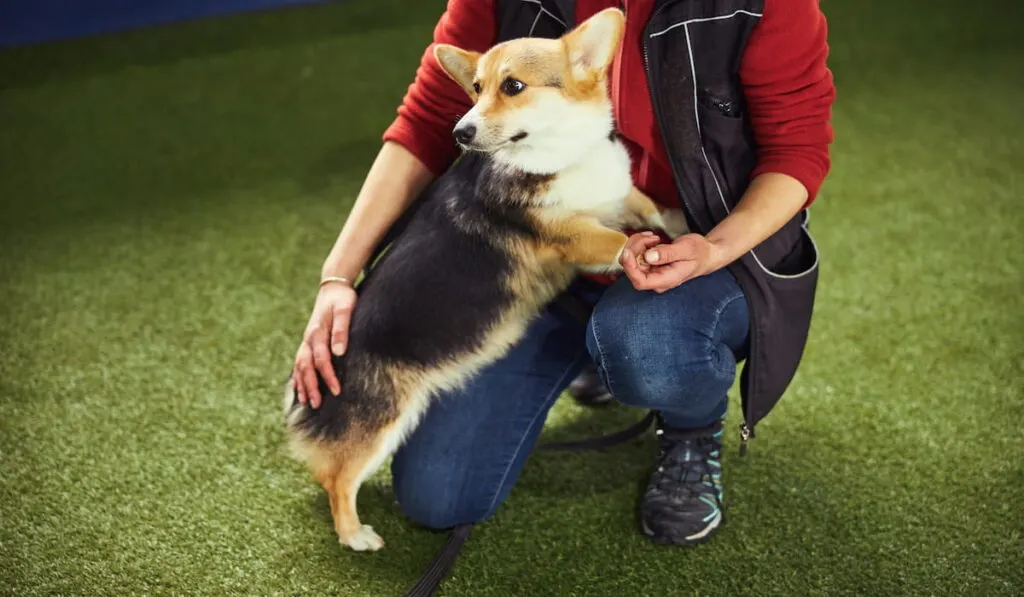Getting a new dog is super exciting but when you are considering a new breed, one that you haven’t really worked with or been around much, it’s normal to wonder about what that type of dog can and can’t do.
As dog breeds go, Corgi’s are one of the cutest, most fun dogs to have. My best friend owns one, Calli, and she is an absolute joy to be around. I’m pretty sure my own pound puppy is a Corgi mix too.
Whether you are an avid hiker looking to get a dog or a current Corgi owner wanting to pick up a new hobby, you will want to answer one important question…
Can Corgi’s Hike?
Corgi’s can hike and they enjoy doing so however you must keep in mind that their short legs make it difficult for them to traverse large, rocky areas. Corgi’s do, however, make an excellent hiking companion for the average recreational hiker.

I’ll discuss some of the considerations you may want to keep in mind when taking your Corgi hiking. Some are specific to the Corgi breed but others are just good general tips for hiking with any dog.
Body Type of Corgi’s and How It Affects Hiking
Whether you own a Pembroke Welsh Corgi or a Cardigan Corgi, the body type you are working with is quite unique.
Originally developed as a herding breed, the Corgi has a noticeably short stature. Their short legs are perfect for accelerating quickly and maneuvering expertly on level ground.
Rocky terrain, steep inclines, and drops are, however, not things that a Corgi’s body type will allow them to excel at.
The Welsh Corgi is great on the flat, and you need to take that into consideration when deciding what types of hikes to take your Corgi on.
Rugged terrain can exert undue stress on your Corgi’s joins. Hips and elbows are especially likely to feel this strain if a Corgi is asked to keep up on a hike that really isn’t suited for their body type.
Of course, there are some types of hikes that Corgi’s are going to be simply unable to complete without being carried or transported by their owners. This is especially true if your hike includes having to navigate large rocks, for example.
5 Tips for Hiking Safely with Your Corgi
As long as you consider your Corgi’s body type for the type of hikes you choose, hiking itself is usually quite safe for the breed. Of course, there are some things you will want to consider.
Here are some tips for hiking safely with your Corgi.
1. Baby Corgi’s Should Only Do Baby Hikes

With any dog, including Corgi’s, it’s best to wait to do moderate or difficult hikes until your Corgi is mature.
While your puppy is growing, the strain of any type can cause damage to your Corgi’s growing body.
Most professionals recommend waiting until your dog is at least one year old before starting moderate to strenuous activity.
That doesn’t mean that your Corgi pup can’t go on a hike, only that you should take into consideration it’s age and maturity before doing so.
Talk with your veterinarian about the distance and types of hikes you are planning to make sure you won’t be causing undue stress on your pups growing body.
2. Consider the Heat
This may seem obvious but it’s extremely important to consider in dogs with thick coats like the Welsh Corgi.
Dogs are often excited to go out and want nothing more than to please their owners by keeping up on a hike. But they also have a hard time telling us when something is wrong.
Try to hike in the cool hours of the morning or towards the late afternoon after the peak temperatures have passed.
In addition, keep an eye on your dog as you hike. Watch for signs of overheating or exhaustion. According to Peconic Vet, these might include:
- Excessive panting
- Slowing down
- Laying down
- Vomiting
- Red Gums
- High Body Temperature
Be sure to also offer your Corgi plenty of water throughout your hike and the opportunity to relax in the shade when warranted.
3. Build Fitness
Just like you wouldn’t ask your friend to go on a 20-mile hike with no experience or training, you should be wary of asking too much of your pup as well.
Once your dog is old enough and physically capable of hiking, you’ll want to start with short hikes and gradually increase the distance.
Keep in mind that Corgi’s may love to go hiking with their owners, but they aren’t designed for it. If you are looking for a long-distance hiking partner, you may be better off choosing another breed.
4. Train for It
We’ve covered fitness above but the training I am talking about here is more behavioral. You’ll want to make sure your Corgi is well behaved and well socialized in public situations.

On the trail, you may encounter many distractions which could cause your Corgi to bolt or even possibly become aggressive. Make sure your Corgi has been exposed to things like:
- Other people walking towards him or passing by him.
- Dogs
- Strollers
- Bicycles
- Uneven Terrain (bridges, rocks, paths)
- Wildlife
Of course, you can’t expose your pup to everything before you go on your first hike but, the more they have been out and around town, the less likely they are to react negatively when something strange is on the trail.
Additionally, you’ll want to make sure you have a solid recall. Even if you plan to keep your Corgi on a leash during the entire hike, there are several situations that could result in you dropping the leash or momentarily losing your grip.
If and when that happens, basic training, especially a recall, will make all the difference between a happy hiking experience with your Corgi, and a nightmare trying to find him in a remote area.
5. Bring Supplies and Be Prepared
Our last tip is to just bring supplies and be prepared. The more you hike with your Corgi the more you will learn what is needed.
Some basic supplies any dog owner should bring on a hike include:
- Reflective Harness (if you are in a hunting area, consider orange)
- Dog Tags
- Leash (I use a reflective one)
- Water Bowls
- Doggy Bags
- Water
Other Supplies for Hiking with Your Corgi
The supplies above are the bare minimum. With those in tow you can safely and easily go on short hikes with your Corgi without issue.
For longer hikes, or if you are just looking for some better ways to accessorize, consider the following:
- Whistle Dog Tracker – I have one of these for my dog and love it.
- First Aid Kit – While they sell pet specific first aid kits, the reality is most human first aid kits contain similar supplies and can easily be used for both you and your pet. Just don’t give him any pain relievers intended for humans!
- Booties – Booties are great to have for especially rocky terrain or when it is hot outside. Be sure to practice with them at home first and get ones that are durable enough for use outside.
- Bell – These are great for alerting hikers, hunters, and even equestrians that you and your dog are coming up the trail. In the unfortunate case your Corgi does get loose, it can also serve to help you locate him.
- Paw Wax – if you have ever had cracked heels you know how painful it can be. Paw wax protects your Corgi’s paws from painful cracking and is great to apply before and during hikes.
You’ll notice I didn’t add backpacks to this list. While sure, you could get one for your Corgi, you’ll want to be super careful not to overload them with “supplies” or extras.
For a short hike, backpacks are typically no problem for a Corgi but, for longer hikes, they should be avoided.
A Corgi’s body isn’t really designed to distribute the weight effectively and you may be setting them up to have a very sore back at the end of what should have been a fun day.

Plan for Poop
I feel like anytime you are talking about hiking with dog’s of any breed it is important to iterate and reiterate the need to plan for poop.
I don’t know how many times I’ve been out hiking and seen where a hiker has literally used their plastic doggy bags to pick up their dogs poop and then tossed the bag to the side.
Remember that when out in the wilderness, the goal is to leave no trace. There are two responsible ways to deal with dog (or human) poop out on the trail:
- Bag it and pack it out
- Bury It
For shorter hikes, bagging it and packing it out is the best option. Tie it to the leash or hang it from your backpack and dispose of it in the first trash receptacle you reach.
In fact, in the case you do want your Corgi to have a stylish backpack, this is definitely an item your Corgi can carry without fear of extra weight hurting their back. Just wrap up the poop and tuck it into the vests pockets.
For longer hikes, consider purchasing an inexpensive backpacker’s trowel. If, and when necessary, bury the poop instead of leaving it out.
You’ll want to make sure it’s at least six to eight inches deep and at least a couple hundred feet from any rivers or lakes. (source)
Why Not Just Leave The Poop On the Trail?
I’ve had friends on hikes with me ask this very question. Why don’t I just leave my dog’s poop on the trail. The wild animals that live there don’t pick up their poop, why should you.
While at a glance this may seem logical there are actually some very good reasons to make sure your Corgi’s poop is disposed of properly when you are hiking. The first is that your dogs poop could make wild animals very sick.
Parasites
Our pets can carry parasites that could be absolutely detrimental to other species. Many parasites, like worms, are shed in a dogs feces.
In addition to worms, dogs carry things in their poop like:
- E. coli
- Coliform bacteria
- Parvovirus
- Girardia
Packing your pups poop out or burying it reduces the risk to wild animals you love to see when you are out on your hike.

Respect for Others
Think about how you would feel as a hiker if you are exploring a beautiful new trail with your dog and all of a sudden you step right in a big pile of poop from some one else’s dog.
Now, your boot is covered in it and the smell is ripe in your nose. Even worse, your dog stepped in it and now his whole paw is covered in it.
Whether you are on a trail that is popular and frequented by others, or one in a seemingly remote location, taking care of your dog’s poop properly helps to make sure others will be able to find the trail poop free, just as you did.
Did you know that Leave No Trace actually did a study in Oregon on the popular Leif Erikson trail and the results were staggering!
In just a 3/4 mile section of a popular hiking trail they found over 50 piles of dog poop or abandoned poop bags. (source)
Final Thoughts
Hiking with your Corgi can be a fun and enjoyable experience for the both of you. Corgi’s love to be out and about and hiking is a great activity for them.
Due to their body structure, Corgi’s are best suited for shorter hikes on level terrain with gradual inclines and declines. They should not carry backpacks or other weighted vests while hiking.
Always check with your veterinarian if you have any concerns about your pet performing an activity with you.
